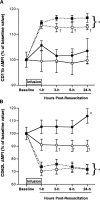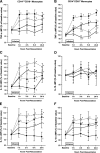The immunomodulatory effects of hypertonic saline resuscitation in patients sustaining traumatic hemorrhagic shock: a randomized, controlled, double-blinded trial
- PMID: 16371736
- PMCID: PMC1449974
- DOI: 10.1097/01.sla.0000193608.93127.b1
The immunomodulatory effects of hypertonic saline resuscitation in patients sustaining traumatic hemorrhagic shock: a randomized, controlled, double-blinded trial
Abstract
Objective: To investigate the potential immunologic and anti-inflammatory effects of hypertonic saline plus dextran (HSD) in hemorrhagic trauma patients.
Background: Unbalanced inflammation triggered by shock has been linked to multiorgan dysfunction (MOD) and death. In animal and cellular models, HSD alters the inflammatory response to shock, attenuating MOD and improving outcome. It remains untested whether HSD has similar effects in humans.
Methods: A single 250-mL dose of either HSD (7.5% NaCl, 6% dextran-70) or placebo (0.9% NaCl) was administered to adult blunt trauma patients in hemorrhagic shock. The primary outcome was to measure changes in immune/inflammatory markers, including neutrophil activation, monocyte subset redistribution, cytokine production, and neuroendocrine changes. Patient demographics, fluid requirements, organ dysfunction, infection, and death were recorded.
Results: A total of 27 patients were enrolled (13 HSD) with no significant differences in clinical measurements. Hyperosmolarity was modest and transient, whereas the immunologic/anti-inflammatory effects persisted for 24 hours. HSD blunted neutrophil activation by abolishing shock-induced CD11b up-regulation and causing CD62L shedding. HSD altered the shock-induced monocyte redistribution pattern by reducing the drop in "classic" CD14 and the expansion of the "pro-inflammatory" CD14CD16 subsets. In parallel, HSD significantly reduced pro-inflammatory tumor necrosis factor (TNF)-alpha production while increasing anti-inflammatory IL-1ra and IL-10. HSD prevented shock-induced norepinephrine surge with no effect on adrenal steroids.
Conclusions: This first human trial evaluating the immunologic/anti-inflammatory effects of hypertonic resuscitation in trauma patients demonstrates that HSD promotes a more balanced inflammatory response to hemorrhagic shock, raising the possibility that similar to experimental models, HSD might also attenuate post-trauma MOD.
Figures




Similar articles
-
Hypertonic resuscitation modulates the inflammatory response in patients with traumatic hemorrhagic shock.Ann Surg. 2007 Apr;245(4):635-41. doi: 10.1097/01.sla.0000251367.44890.ae. Ann Surg. 2007. PMID: 17414614 Free PMC article.
-
Resuscitation of traumatic hemorrhagic shock patients with hypertonic saline-without dextran-inhibits neutrophil and endothelial cell activation.Shock. 2012 Oct;38(4):341-50. doi: 10.1097/SHK.0b013e3182635aca. Shock. 2012. PMID: 22777113 Free PMC article. Clinical Trial.
-
Prehospital resuscitation with hypertonic saline-dextran modulates inflammatory, coagulation and endothelial activation marker profiles in severe traumatic brain injured patients.J Neuroinflammation. 2010 Jan 18;7:5. doi: 10.1186/1742-2094-7-5. J Neuroinflammation. 2010. PMID: 20082712 Free PMC article. Clinical Trial.
-
Hypertonic saline resuscitation.Medicina (B Aires). 1998;58(4):393-402. Medicina (B Aires). 1998. PMID: 9816702 Review.
-
Controversies in shock research: hypertonic resuscitation--pros and cons.Shock. 1995 Jan;3(1):69-72. Shock. 1995. PMID: 7531605 Review.
Cited by
-
Fluid resuscitation: past, present, and the future.Shock. 2010 Mar;33(3):229-41. doi: 10.1097/SHK.0b013e3181c30f0c. Shock. 2010. PMID: 20160609 Free PMC article. Review.
-
Peripheral osmotic stimulation inhibits the brain's innate immune response to microdialysis of acidic perfusion fluid adjacent to supraoptic nucleus.Am J Physiol Regul Integr Comp Physiol. 2009 Nov;297(5):R1532-45. doi: 10.1152/ajpregu.00340.2009. Epub 2009 Sep 16. Am J Physiol Regul Integr Comp Physiol. 2009. PMID: 19759333 Free PMC article.
-
Oxidant alterations in CD16 expression are cytoskeletal induced.Shock. 2009 Dec;32(6):572-7. doi: 10.1097/SHK.0b013e3181a72530. Shock. 2009. PMID: 19333136 Free PMC article.
-
Effect of Hypertonic Saline Infusion versus Normal Saline on Serum NGAL and Cystatin C Levels in Patients Undergoing Coronary Artery Bypass Graft.J Tehran Heart Cent. 2013 Jan;8(1):21-7. Epub 2013 Jan 8. J Tehran Heart Cent. 2013. PMID: 23646044 Free PMC article.
-
A novel fluid resuscitation strategy modulates pulmonary transcription factor activation in a murine model of hemorrhagic shock.Clinics (Sao Paulo). 2010 Jun;65(6):621-8. doi: 10.1590/S1807-59322010000600010. Clinics (Sao Paulo). 2010. PMID: 20613939 Free PMC article.
References
-
- Moore FA, McKinley BA, Moore EE. The next generation in shock resuscitation. Lancet. 2004;363:1988–1996. - PubMed
-
- Giannoudis PV. Current concepts of the inflammatory response after major trauma: an update. Injury. 2003;34:397–404. - PubMed
-
- Maier RV. Pathogenesis of multiple organ dysfunction syndrome: endotoxin, inflammatory cells, and their mediators. Cytokines and reactive oxygen species. Surg Infect (Larchmt). 2000;1:197–205. - PubMed
-
- Rizoli SB, Rotstein OD, Sibbald WJ. The immunological effects of hypertonic saline. In: Vincent JL, ed. Yearbook of Intensive Care and Emergency Medicine. Berlin: Springer-Verlag, 2002:446–453.
-
- Rotstein OD. Modeling the two-hit hypothesis for evaluating strategies to prevent organ injury after shock/resuscitation. J Trauma. 2003;54(suppl):203–206. - PubMed
Publication types
MeSH terms
Substances
LinkOut - more resources
Full Text Sources
Research Materials

